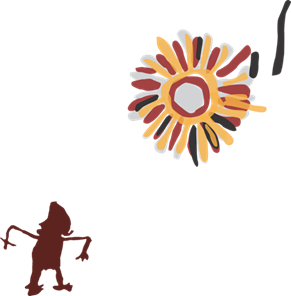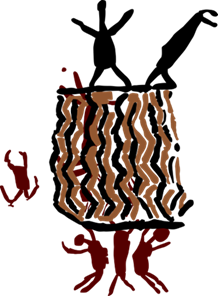Call for paper - Aesthetics of Archaeology Dossier: Dialogues Mediated by Rupestrian Images

Figure 1
Aesthetics of Archaeology Dossier: Dialogues Mediated by Rupestrian Images
Call for papers Arte Filosofia
Editors:
Carla Milani Damião (UFG)
Rogério Tobias Junior (UFMG/Instituto Prístino)
Celina Lage (Escola Guignard-UEMG)
Lílian Panachuk (UFMG)
Deadline for submission: 20/12/2025
The aim of this dossier is to go beyond a merely multidisciplinary relationship between Aesthetics and Archaeology. It seeks to bridge modes of exchange and particular ways of experiencing rock art, individual and collective experiences with such materialities and practices based on convergences, overlaps, juxtapositions, and specific temporalities in both fields. This dialogue is based on two recent curatorial experiences (Pedras pintadas/Painted Stones at the UFG Cultural Centre in Goiás, 2024 and Grafismos na Pedra: as artes rupestres brasileiras/Graphisms on Stone: Brazilian rock arts at the UFMG Museum of Natural History and Botanical Garden, 2024/2025, in Minas Gerais).
From Philosophy and Aesthetics, we gather many metaphors of methodological content that draw on Archaeology and its interfaces with Palaeontology (Merleau-Ponty, The Visible and the Invisible, 2003) or Geology (Benjamin, "Naples", 2023; "To excavate and to remember", 2017). Methods that require returning to historical time in depth, generating images that approximate excavation practices, materiality, and corporeality. By taking Archaeology as a model, philosophers and aesthetes move away from the artistic categories and models that condition normative aesthetic theories and approach the quality of the aesthetic that permeates our daily lives through times and places. Of the normative categories of modern aesthetics subjected to severe criticism, given their European ethnocentric values and judgments (McDonald and Veth, 2012), few remain in this new perspective, among which is the certainty that "perception" (from the Greek aesthesis) is a common term and of deep roots in the research of one area and the other.
From Archaeology, in its interfaces with Anthropology, Ethnology, and History, we bring expectations about form, so traditionally considered from ethno-cultural or stylistic categories. We glimpse other aspects, sparsely addressed but frankly present in the daily lives of researchers and their research. It is an expansion of perspectives given as possible in the study of rupestrian images, from, for example, the emphasis on process, performance, movement, path, temporality, and that calls for the understanding that people and beings are co-participants in the emergence of traces, figures and the production of other beings or things through the act of writing (Linke et al, 2020). Such perspectives glimpse collective powers that admit places and things as vertices, and processes and movements as lines that together intertwine different aspects of human experience. Of these lines, making things presents itself as a way of inhabiting the world and engaging in it: from the one who writes to the one who asks what is written/was written, technique and technology are placed as means to experience such processes, to approximate different forms of habitation or even, to provoke changes in contemporary habitation (Ingold, 2013). From the perception in the field that involves bodily movements and gestures, whether in the territorial scope, in the experience of making or in the documentation of rupestrian images, whether in the capture or digital processing of images in the laboratory, to the public exhibition of their results, we perceive in the mediating work of Archaeology a complexity that is not alien to the procedures originated from aesthetic experience.
Aesthetics is precisely the field that combines these multiple forms of approach, bringing together cognition, sensation, imagination, affect and corporeality (Roelofs, 2025) in the relationship that is established within experience, in the form of reciprocal and mediated addressing of the captured, processed and disseminated images. The perspectives of indigenous peoples have been strongly impacting the archaeological work and subverting Western notions of heritage, art and technology, emphasizing the dynamics, humanity, animality and tensioning hegemonic dichotomies. In this same way, Afro-centred perspectives focus on different traditional issues and launch new provocations to think about archaeology, pointing to new methodologies and concepts, bringing relationality, positionality and corporality. The understanding of a situated science brought to the fore desires for new productions of images, new repertoires, new narratives.
Archaeology, then, has become permeable to aspects previously discarded, assuming to be affected, involvements and correspondences that allow us to understand it as another form of inhabitation, bringing aesthetics to a game previously dominated by objectivity and generalization. We propose, as this dossier’s theme, an aesthetics of archaeology as a possibility to bridge confluent aspects between the areas, however, respecting the distinctive marks of their own tasks and purposes. We aim, above all, by showing the affinities, to undo normative prejudices and resort to the possible or even necessary normativity, in a careful and responsible way.
Original texts, image productions, interviews, translations and reviews will be accepted by October 5th, 2025, and should be submitted to the 'Aesthetics of Archaeology' Section. The subtopics below aim to guide discussions for authors before articles’ submission.
Subtopics:
- Rupestrian images, traditions and the question of style;
- Aesthetic experience in the field: perception, sensation, imagination and cognition;
- Technological aspects of rupestrian image making: performance, gesture and line, applicators, inks and other devices;
- Ephemerality and survival of images (paintings and engravings) on rocks;
- Purpose of form and final form;
- Theories of image and use of metaphors related to archaeological practice;
- From the research and field work to exhibition;
- Production of analogic and digital mediators;
- Curatorship: selection, addressing to the public and exhibition;
- What remained in the technical reserve?

Figure 2
----------
Figure 1: Anthropomorphic figure from the archaeological site GO-CP-06 in Palestina de Goiás-GO, vectorized by Carla M. Damião, composed with Radiated Circle from the Lapa do Sol site in Jequitaí-MG, vectorized by Rogério Tobias Jr.
Figure 2: Lapa da Mamoneira-MG Archaeological Site, vectorized by Rogério Tobias Jr.

